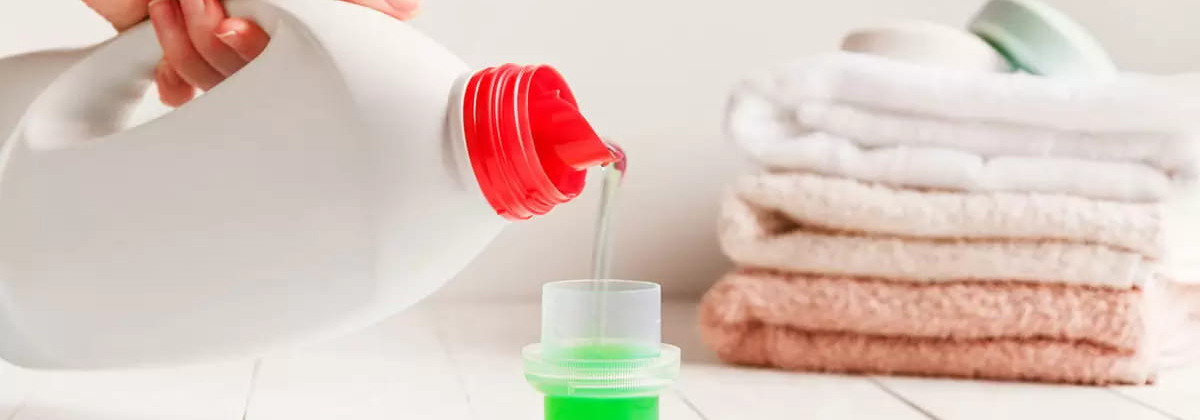24 Nov Washing Liquid or Dishwashing Liquid? Which One is Better?
The most important reason for the widespread use of washing liquid today is its cleaning power and mild detergent properties. One of the most widely used detergents at home is washing liquid. Different clothes cleaners are found in all homes, and washing liquid is an excellent alternative to these solid chemical detergents. No one likes to be left with stains or detergent residue after washing clothes. Therefore, most people are looking for a suitable substitute to remove stains from clothes. In this article, we will discuss the difference between washing and dishwashing liquid and then explain how to use washing liquid. So stay tuned to the end.
The difference between washing liquid and dishwashing liquid
All detergents, whether designed for hands, hair, clothes, or dishes, work on the same principle: detergents loosen grease and grime and wash them away with water. However, each product is manufactured for specific conditions and can’t usually be used in other cases.
The difference between the formulation of laundry liquid and dishwashing liquid
Dishwashing liquid contains softening substances that aren’t found in washing liquid. Companies add mild additives to dishwashing liquid to prevent abrasion or skin irritation. These additives may include humectants, oils, and protein compounds. Many dishwashing detergents also contain antibacterial ingredients that protect the hands’ skin. These ingredients are specifically designed to come into contact with skin and aren’t found in most laundry detergents. On the other hand, many elements in washing liquid aren’t found in dishwashing liquid. These add-ons include:
- Elements that increase the effectiveness of active substances on the surface by deactivating hard water minerals.
- Polymers (anti-sediment agents) help to absorb and maintain the colour of fabric fibres and prevent water minerals from depositing on clothes.
- The oxygen that is present in some laundry detergents and has bleaching properties doesn’t harm the colour of coloured clothes.
- It is softening elements reduce fabric friction and static electricity levels.
- Elements that protect the internal parts of the washing machine from rusting due to washing.
The difference between the pH of washing liquid and dishwashing liquid
The most crucial difference between washing and dishwashing liquid is the presence or absence of bleach and surfactants, which causes a difference in the pH level of the material. Surfactants absorb water from one side and oil from the other. These molecules, which are present in the composition of detergents, eliminate the distance between water and fat in the stains showing their cleansing effect in the washing process.
Many of the detergents in your dishwasher use a solid formulation to remove stains. The effect of this formulation is awe-inspiring for removing food stains. But at the same time, the compounds used in these detergents raise their pH significantly, which is very harmful to the skin. Therefore, they shouldn’t be used to wash dishes by hand. Dishwashing detergents for hands don’t contain bleaching agents and contain active ingredients at a pH level almost neutral.
The pH of laundry liquid is higher than that of dishwashing liquid, but at the same time, this amount isn’t enough to damage the colour and fibres of fabrics. The pH of laundry detergents produced in powder form is closer to the pH of the detergents you use in the dishwasher. Meanwhile, liquid laundry detergent has a more neutral pH. Also, these detergents contain enzymes to break down protein, starch and fat stains and help break down oil molecules and all kinds of stains. Also, the washing liquid is less sensitive to water hardness and dissolves more easily.
Can washing liquid be used to wash dishes?
To wash dishes in dishwashers, you must use special detergents. If you replace the washing liquid, don’t expect the final washing result to be satisfactory. If you use them in the dishwasher, there are substances in the washing liquid that will heat up inside the machine and produce toxic gasses from heating. Inhalation of these gasses may be dangerous. These chemicals are stain removers, fragrances and clothes brighteners.
If you use laundry detergent in hand washing, it prevents the release of dangerous chemicals. But it’s possible that when rinsing the dishes, these materials aren’t washed thoroughly and finally, by remaining on the dish’s surface, they become a problem for your health. Most of the ingredients in the washing liquid have been selected to have a long-lasting effect on the clothes. So, the fragrance and gloss molecules are stable and aren’t easily washed off. You don’t want to eat in a container full of harmful chemical molecules. If you don’t have a suitable detergent for washing dishes in the dishwasher and prefer a more effective substance than dishwashing liquid, go for liquid soaps or bath gel. But after the machine is finished, remove the dishes and rinse them by hand in the sink again.
Can dishwashing liquid be used in a washing machine?
Some people use dishwashing liquid to wash clothes in the washing machine to get cleaner clothes by producing more foam. But using this method causes problems in the long run. One of the reasons that dishwashing liquid is problematic in a washing machine is that excessive foaming of dishwashing liquid can damage your device. This amount of foam is only suitable for washing dishes by hand. You might think that lathering up a lot of dishwashing liquid will have a brilliant effect on cleaning your clothes. But the reality is that the washing machine pump and water drain will have problems, and the clothes won’t get as clean as you want them to! The traces of washing-up liquid will remain on your clothes and make them dull.
The difference between washing and dishwashing liquid is that you can’t replace these two substances when washing clothes. Dishwashing liquid is effective in destroying microscopic microbes; Because it destroys them by surrounding their molecules after washing with water. On the other hand, washing liquid directly affects the performance of water in another way and works better in washing clothes. These detergents have activating elements that reduce water’s surface tension and cause proper water distribution on the clothes. The creation of this constant humidity easily removes stains from clothes and removes them. But the dishwashing liquid doesn’t have this group of activating elements, so they don’t clean the clothes as they should. The difference between washing liquid and dishwashing liquid is enormous, and the way they work is significantly different. Therefore, it’s better to use them in the right place and not use them interchangeably.
Using washing liquid
Chemical detergents are known for their high cleaning power. But if you aren’t familiar with how to use detergents, it can lead to risks and harm to people. You must use it correctly to get the most out of washing liquid. Before washing clothes, take the necessary steps to remove stubborn stains. So, pour a small amount of detergent on the stains and rub it on the stain to cause the liquid to penetrate deep into the clothes fibres.
The place of fabric softener and washing liquid are different; you can pour the liquid into its special drawer or fill a particular ball with laundry liquid and put it in the washing machine pot along with the clothes. If you pour the liquid in the wrong place, the detergent will cause a white stain on the clothes, or it will leave the washing machine tubes before entering the drum, and the clothes won’t be cleaned well. Before using the washing liquid, read the dosage on the package and use detergent according to the number of clothes.
Using a washing liquid suitable for washing by hand is the best option for washing clothes. In this method, it’s enough to pour some liquid into a bucket or tub and dissolve it well in water. Then, put the clothes in the water and detergent solution and wash them by hand. Rub the stains on the clothes well until they disappear entirely. After taking the clothes up and down a few times, run them under cold water to remove the detergent and dirt. Detergent residue on clothes can cause allergies.
How to use detergents when washing by hand
Acidic substances in cleaning products cause dryness and aging of the skin. Therefore, use gloves when washing clothes by hand. After finishing the work, please wash your hands with cold water and moisturize them with the appropriate cream. Never mix detergents with hot water; Because chemical reactions occur that can make breathing difficult.
To wrap up
With the advancement of science and technology, advanced washing machines have been released to the market. Using new devices has made our work easier. But don’t forget that care, using the correct method, and using suitable detergents are essential in washing clothes with a machine. Knowing the advantages and disadvantages of detergents can reduce the loss of washing liquid for the device. If you don’t have the opportunity or patience to wash your clothes, you can count on the specialized NeatEx team. With the most advanced tools and the latest knowledge, we will deliver your clothes of the best quality as soon as possible. Don’t damage your valuable clothes with improper washing. NeatEx washes your clothes best and ensures you have clean and tidy clothes.




Sorry, the comment form is closed at this time.